Antarctica Whales: Pictures, Facts and Information

A favourite among Antarctica cruise goers, whales are beautiful, enigmatic and fascinating creatures.
Highly intelligent creatures with complex social lives, Antarctica whales capture the imagination of all Antarctica travelers.
Few sights on earth can beat seeing a pod of Killer whales or seeing a Humpback breaching the surface of the water.
Almost 75% of the worlds Killer whales live in Antarctica and if there is one place on earth that could be seen as a whales paradise – its Antarctica!
People lucky enough to get close to them can experience their awesome size and their smooth movement through the water.
If you’re lucky enough to spot a Blue whale on your Antarctica cruise you’ll be looking at the largest creature to ever roam the earth, including dinosaurs!
Whales are not fish – they belong to the mammal species known as Cetaceans. This branch of mammals encompasses whales, dolphins and porpoises.
Like any other mammal, whales need to breathe which forces them to the surface of the water every 20 minutes or so.
Whales never breed in Antarctica, preferring the more temperate climates for their young. However, Antarctica is actually a hot spot for whales due to the rich pickings of marine food, including large numbers of krill!
Therefore, all Antarctic whale species migrate south during the summer months to take advantage of the nutrient rich sea. The rich marine life is what makes Antarctica the perfect place to go whale watching.
Save Big on Your Antarctic Cruise
Antarctic cruise deals don’t last long – some cabins sell for 30–40% less than the regular price.
We check every major provider each month to uncover limited-time offers so you can experience the world’s last great wilderness for less.
Antarctica Whales
Blue Whale
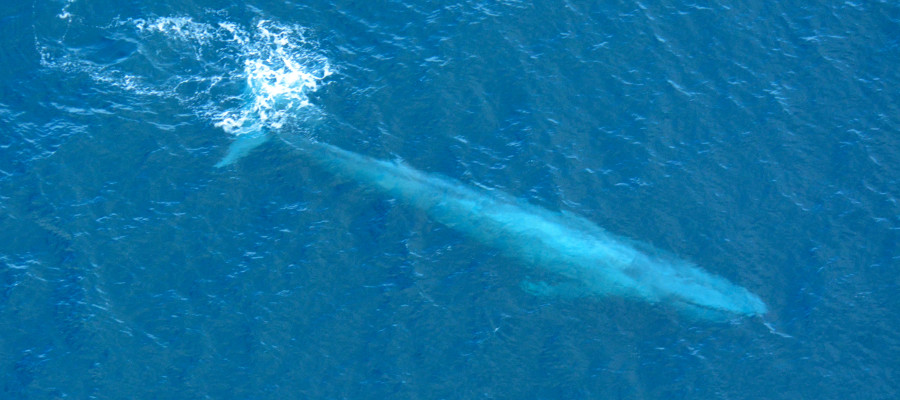
Probably the most awesome creature on earth, the Blue whale is bigger than any previous living creature on earth with an average weight of 120 tones and length of 30 meters!
Everything about a Blue whale is enormous. Their heart is the size of a small car and pumps 10 tonnes of blood around its body! Their tongue weighs the same as a fully grown elephant.
A small child could crawl through a Blue whale’s blood vessels and they consume over 5 tonnes of food per day in the feeding season!
Although Blue whales are actually grey, they acquired their name because, when seen under the surface of the water, they glow a luminous blue colour.
Their mottled skin, luminous aqua blue colour and sheer size make identifying the Blue whale relatively easy.
Blue whales are ‘Baleen’ whales (no teeth) and consume krill by taking enormous gulps of krill rich sea water and then sifting the water out through its fringed baleen plates.
It is thought that the Blue whale will eat for 8 months of the year when the waters are at their most nutrient and then fast for the remaining 4 months, living off their fat reserves.
Blue whales tend to swim alone or in pairs, cruising the worlds largest oceans. However, they are actually one of the loudest creatures on earth and, in good conditions, their moans and groans can be heard by other Blue whales up to a 1,000 miles away!
Blue whale calves actually enter the world as one of the largest creatures on earth, weighing around 3 tones and 8 meters long.
The calf’s diet consists purely of its mother milk and will grow 90 kg (200 lb) in size each day for the first year! Blue whales are also one of the longest living creatures on the planet with some Blue whales living in excess of a 200 years!
Although not a common sight on an Antarctica cruise, they are still seen regularly as Antarctica is one of their favourite hunting grounds!
Blue Whale Facts
Size and weight:
Feeding: The largest animal on earth measuring on average around 30 meters! Females are generally larger than males. They weigh a whopping 120 tons on average but have been known to weigh over 200 tons!
Dive Duration: Blue whales stay under longer than most whales with an average dive duration of 30 minutes.
World Population: 12,000 is the current estimate – far more in pre-whaling times.
Distribution: Found in all oceans.
Conservation Status: The are still classed as endangered, although their population is increasing.
Life Span: Usually about 90 years it is believed.
Killer Whales (Orcas)

One of the most recognizable creatures in the world, let alone Antarctica, Killer whales are our personal favourites!
Their beautiful markings, cunning hunting techniques and playful nature make them one of the best animals on an Antarctica cruise to observe.
One of the worlds greatest predators, Killer whales are toothed whales and stand at the top of the food chain.
They eat a wide array of marine life from penguins and seals, to fish and other whales. Pods of Killer whales have even been known to eat Blue whales!
When hunting, an entire pod will work together using a constant stream of clicks and calls to communicate. They are without doubt one of the most intelligent hunters in the animal kingdom, often using radical techniques.
Most famous among these are the pod of Killer whales that hunt off the coast of Valdes in Patagonia. This pod actually uses the incoming tide and waves to propel themselves onto the beach to get the seal pups!
In Antarctica, Killer whales will often follow the new season ice breaker ships to reach further inland in search of seals.
A common sight in Antarctica is Killer whales head popping up in the ice as it searches for seals. If it sees one they will cunningly tip the ice flow that the seal is lounging on so that it slides into the water.
Male Killer whales are larger than females and easily identifiable by their tall, straight dorsal fins that can reach 6 foot in height! By contrast, the females dorsal fin is less than half this size and curves back more.
Killer whales are very social creatures and generally stay with their pod or family for life.
Killer Whale Facts
Size and weight: The largest of the dolphin family, Killer whales weigh around 10 tons and measure about 10 meters in length.
Feeding: Killer whales are the oceans best predator and will eat, fish, penguins, seals and other whales!
Dive Duration: Killer whales generally stay underwater between 3 and 5 minutes. They have been known stay underwater for more than 15 minutes though.
World Population: 100,000 is the latest estimate.
Distribution: Found in all oceans, although most common in Antarctica.
Conservation Status: There is insufficient data to say.
Life Span: Anywhere between 35 and 50 years.
Humpback Whale
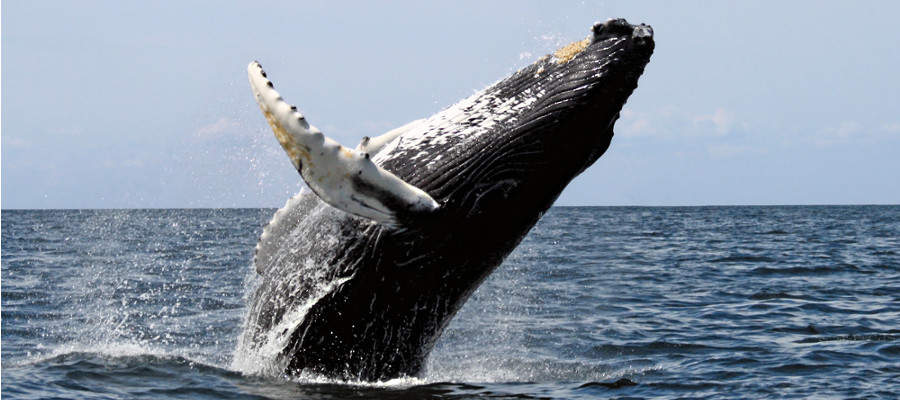
Probably the most sighted whale in the world, Humpbacks are so named because of the way they raise and bend their back when preparing to dive.
Humpback whales are slow and shallow swimmers, making them ideal for Antarctca cruise goers to spot.
Humpbacks could easily be describes as the acrobats of the whale world as their often seen breaching and slapping the water. They also have the longest flippers of any baleen whale and can often be up to a third of the whale’s body length!
Humpbacks are notorious for their barnacled and scarred skin. They have distinctive white markings on the underside of their tail which marks out each individual like a finger print.
Like the Blue whale, Humpbacks are gulpers and take in huge mouthfuls of krill rich seawater and sieve the seawater back out.
Whilst in Antarctica Humpbacks feed exclusively on krill, in other more temperate waters they will eat a wide array of fish including mackerel, anchovies, sand eels, capelin, herring, pollock and cod. They catch the fish by either herding them with a pod of whales or slapping them the fish with their large tail fins and stunning them.
Humpbacks will often travel alone or in very small groups. Some groups can be as many as 4 or 5 whales, however, groups rarely stay together and this may just be an opportunistic hunting method.
Mothers and calf will stay together for a considerable time, sometimes joined by the father. The only time real fights break out is when another male approaches a family during this period.
Humpback Whale Facts
Size and weight: Average length of 13 meters (43 ft) but have been known to get to 19 meters. Humpbacks generally weigh between 25 and 35 tons.
Feeding: Almost always eat krill.
Dive Duration: Have been know to stay under water for over 30 minutes, but usually between 7 and 10 minutes.
World Population: There is an estimated 30,000 – 40,000 humpback whales.
Distribution: All oceans.
Conservation Status: Population is increasing so Humpbacks have a status of ‘least concern’.
Life Span: Roughly 50 years.
Minke Whale
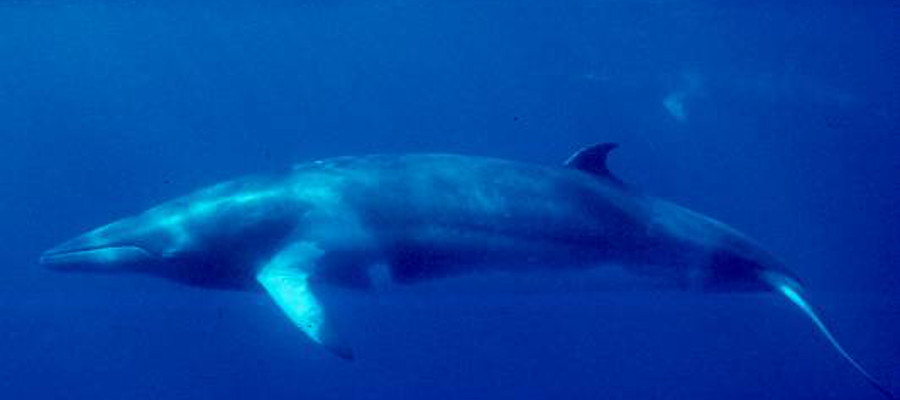
Minke whales, pronounced ‘Minky’, are the second smallest whales species in the world.
They are extremely inquisitive creatures and will often approach stationary boars, making them great whales to spot on an Antarctica cruise.
Minke whales have a sharply pointed snout and their bodies are extremely streamline. Their skin is very smooth, free from barnacles and callosities.
They’re still the only whale that is regularly killed for its meat, although Japan classes it as ‘research. However, many of the Minke whales killed for research end up in the local markets as meat. Japan is not the only country to still do this, others include Norway and Iceland.
Although Minke whales are solitary animals, groups of up to 20 have been seen around boats. They often breach the water and swim beside boats at up to 20 kmh.
They’re found in all oceans but tend to prefer cooler waters, often staying in one area all year-round. They are rarely seen in the tropics.
Minke Whale Facts
Size and weight: The second smallest whale on earth, the Minke whale typically measures 10 meters (35 ft) long and weigh around 15 tons. Females are usually slightly bigger.
Feeding: Almost exclusively on krill.
Dive Duration: Roughly 20 minutes.
World Population: There are an estimated 800,000 Minke whales.
Distribution: Minke whales only inhabit southern hemisphere oceans.
Conservation Status: Minke whales are going strong according to recent research and have a conservation status of ‘least concern’.
Life Span: 30 – 50 years is the latest estimate.
Save Big on Your Antarctic Cruise
Antarctic cruise deals don’t last long – some cabins sell for 30–40% less than the regular price.
We check every major provider each month to uncover limited-time offers so you can experience the world’s last great wilderness for less.
Sei Whale
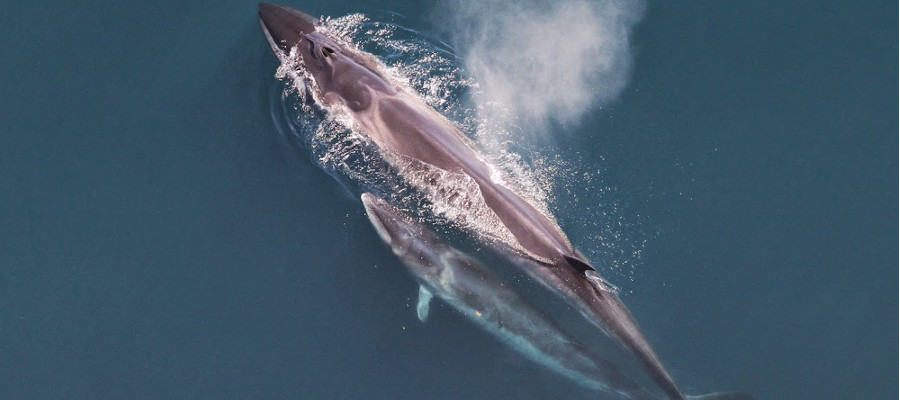
A very solitary animal, Sei whales are one of the most elusive types of whale.
Pronounced ‘Say’, Sei whales were decimated by early commercial whaling when stocks of Blue and Fin whales ran low.
Although found in all oceans, Sei whales prefer more temperate waters and are actually quite rare in Antarctica. Instead of gulping krill, Sie whales actually tend to skim feed on zooplankton, preferring to avoid the nutrient rich waters in the summer.
This way they avoid competition from other whales and are able to patrol their own feeding area.
Although rare to spot on an Antarctica cruise, feeding Sie whales are easy to see if you’re in the right area as they tend to stay very near the surface, diving and breathing at regular intervals.
Sei whales are one of the only whales with a dorsal fin. They’re also considered to be the fastest whale on earth, reaching speeds in excess of 50 kmh over short bursts!
Sei Whale Facts
Size and weight: Typical length of about 17 meters, however, females tend to be several meters longer. Average weight of 35 tons.
Feeding: Mainly krill in Antarctica, but their diet does vary in other regions.
Dive Duration: 20 minutes is the average.
World Population: A rough estimate of 30,000 – much more pre-whaling.
Distribution: Found in all oceans, although Sei whales do prefer water temperatures between 8 – 18°C
Conservation Status: Considered endangered as the population has decreased.
Life Span: Usually around 60 years.
Southern Right Whale
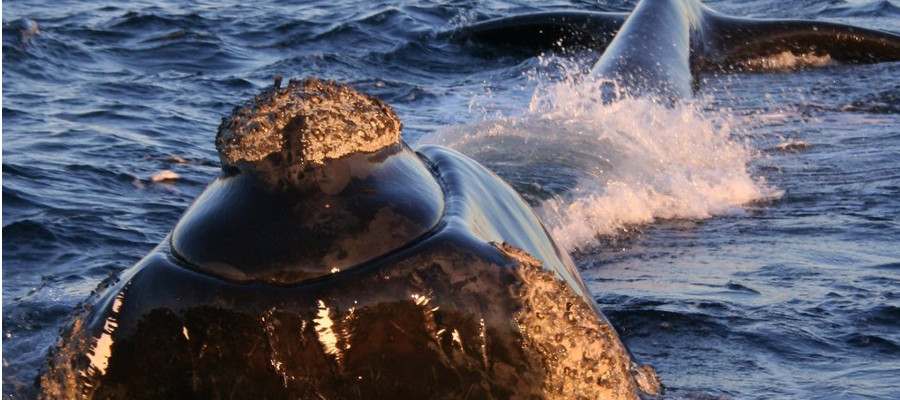
The Southern Right whale is one of three Right whale species and is a baleen type whale.
Its two blow holes make a distinctive v-shaped spray that can be spotted from some distance!
Right whales take their name from early whalers who described these whales as the ‘right’ whales to catch due to their high blubber and oil levels. Luckily, these animals are no longer hunted.
The Southern Right whale has an enormous head – about one quarter of its body length. The species are known for having large callosities on their head that is unique to each animal.
The callosities are made of a finger-nail like material which form a white colour due to the large amount of whale lice that live on them.
Southern Right whales like shallow water like bays and have been known to swim in as far as the surf!
They often delight Antarctica cruise goers by breaching and sticking their tails in the air.
Southern Right Whale Facts
Size and weight: Average length is roughly 18 meters (57 ft), however, females are generally slightly longer. Their full adult weight is normally 100 tons.
Feeding: They feed almost solely on krill when in the Antarctic region.
Dive Duration: Roughly 20 minutes.
World Population: Only about 7,000 are estimated to be alive. This is up from the 1920’s when there was an estimated 300 after the whalers stopped!
Distribution: Pretty much everywhere from the poles to the tropics.
Conservation Status: Because their population is increasing, they have a status of ‘least concern’.
Life Span: Very little is know about their life span, however, several studies suggest in the region of 70-80 years.
Fin Whale

The fin whale is the second largest animal on earth and is one of the quickest whales in the ocean, often being referred to as the greyhound of the seas.
Reaching speeds of nearly 50 kmh, Fin whale often outrun the fastest of ocean steamships.
Like most fast swimming whales, the Fin whale is free of any barnacles and has a very stream line shape that allows it to cover great distances at speed.
Strangely, the lower right section of the Fin whales jaw is always white. Like the Blue whale, the Fin whale is a baleen whale that gulps large quantities of sea water that is rich in krill and the sieve’s the water out through its baleen plates.
Fin whales are more social than most other species and often cruise in pods of up to 7 whales.
They tend to work together for rounding up krill and will often dive in excess of 200 meters in search of food. Fine whales often eat over 2 tonnes of food per day.
Like many whales, Fin whales migrate to warmer waters in the winter months and often cover well in excess of 150 km in one day during this migration period!
Fin Whale Facts
Size and weight: Fin whales average around 50 tones with a typical length of about 25 meters (85 ft). However, they have been know to weigh well over a 100 tons!
Feeding: Although Fin whales mainly feed on krill, they are opportunistic and will also feed on fish.
Dive Duration: Usually around 20 minutes
World Population: There are an estimated 80,000 left.
Distribution: World wide in all oceans.
Conservation Status: Classed as endangered.
Life Span: Roughly 90 years.
Sperm Whale
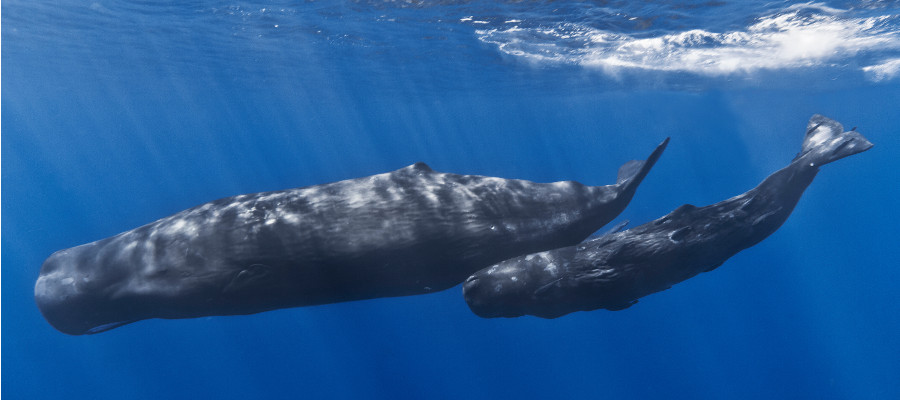
Only male Sperm whales are found in Antarctica. Because of sexual dimorphism, males are far larger than females, usually about one and half times their size and double their weight!
Sperm whales are Odontocetes whales – they have teeth. Strangely though, Sperm whales only have teeth on their lower jaw. They are easily the largest toothed animals on earth.
Sperm whales also dive far deeper than other whales, often diving down to 500 meters. Some Sperm whales have been known to dive as deep as 3,000 meters! They dive deeply in order to hunt Giant Squid – their staple prey.
Sperm whales have the most distinctive blow of any whale. Their blow spray angles sharply forward in a leftward direction and blows as far as 5 meters!
Sperm whales have large and close-knit extended families, often exceeding 50 whales. These whales will be bonded for life, particularly females.
They are similar to dolphins in that certain members of the family will show a preference to other certain members – perhaps parents.
Sperm Whale Facts
Size and weight: The average length of Sperm whales is about 13 meters (45 ft). Females are generally 2 or 3 meters longer. Sperm whales weigh 30 tons, although some have been double this!
Feeding: Unlike most whales, Sperm whales generally feed on deep water squid.
Dive Duration: By far the longest divers in the whale family, Sperm whales have a dive duration of 90 – 140 minutes!
World Population: There is an estimated 1 million Sperm whales.
Distribution: Found in all oceans but prefer deep waters.
Conservation Status: They are classed as vulnerable due to population decrease.
Life Span: Between 60 and 70 years.
Save Big on Your Antarctic Cruise
Antarctic cruise deals don’t last long – some cabins sell for 30–40% less than the regular price. We check every major provider each month to uncover limited-time offers so you can experience the world’s last great wilderness for less.

Mark W
USA
FAQ
If you would like to know more about any of the Antarctica whales mentioned above please leave a comment below and we will endeavor to get back to you within 24 hours! Alternatively, please see our FAQ page here. If you would like to get a cruise quote, please use this form.
Thank you - AntarcticaGuide Team
